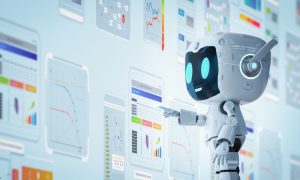The financial world moves at lightning speed. I’ve seen this firsthand in my businesses. Financial forecasting used to take days of manual work. Teams would struggle with spreadsheets and outdated data. The results were often inaccurate and arrived too late. AI has changed everything. Financial institutions now make decisions based on real-time insights. They spot market trends before competitors do, and they manage risks more effectively than ever before.
Have you wondered how major banks predict market changes so accurately? The answer lies in AI-powered forecasting tools. These tools process massive amounts of data in seconds. They find patterns humans would miss. They learn from past predictions to improve future ones.
In this article, I’ll show you exactly how AI has transformed financial forecasting. You’ll learn how businesses use these technologies today. You’ll discover how to apply these principles to your financial decisions.
AI in Automated Data Analysis

Back in the day, data analysis was pure torture. Some poor analysts hunched over spreadsheets until 2 AM. Data cleaning alone took forever. Half the time, they worked with incomplete information because deadlines couldn’t wait.
Fast-forward to now—AI handles that grunt work automatically. It cleans data while you grab coffee. It finds connections across thousands of variables simultaneously. New information comes in? Forecasts update on the fly.
What’s crazy impressive is how AI tackles unstructured data. News articles, Twitter rants, earnings call transcripts—it digests them all. Then it pulls out golden nuggets that actually move markets. Your traditional models never stood a chance.
These machine learning algorithms are like financial bloodhounds. They sniff out subtle market patterns. They catch seasonal trends that only show up every few years. When something weird pops up? They flag it and adjust predictions accordingly.
AI in Predictive Modeling
Predictive modeling has advanced significantly since I started in business. Old-school models used only a handful of variables and relied on basic stats that my college professor taught back in 2001. Complex market dynamics? Forget about it.
Today’s AI models pack serious heat. Neural networks learn from historical data like brilliant students. They spot crazy-complex relationships between seemingly unrelated factors. Market conditions shift? They adapt without human intervention.
How these systems juggle thousands of factors at once blows my mind. Economic indicators, quarterly reports, investor sentiment, and alternative data like parking lot satellite imagery are all processed simultaneously.
AI in Risk Management
Risk management pre-AI was basically reactive. Teams spotted problems after they’d already caused damage. They obsessed over historical patterns that often proved useless in new situations. Novel threats? Total blind spot.
AI flipped the script to proactive protection. Systems monitor transactions as they happen. Unusual patterns trigger immediate alerts. Small issues get squashed before morphing into five-alarm fires.
Fraud detection especially shines with AI enhancements. The tech builds behavior profiles for every customer. Transactions that break normal patterns get flagged instantly. Every case, whether a false alarm or a real threat, improves future detection.
Credit risk? Night and day difference with AI. Traditional credit scoring looked at maybe 10-20 factors tops. Modern AI models consider hundreds of variables. They routinely identify solid borrowers that old models would’ve rejected outright.
Regulatory compliance becomes less painful too. AI systems constantly monitor communications for potential red flags. They ensure transactions satisfy current regulations. When rules change? They adapt quickly without massive retraining efforts.
AI in Customer Service and Personalization

Remember when “personalized banking” meant the teller knew your name? Traditional customer service followed rigid scripts, and financial advice came in one-size-fits-all packages. The experience felt about as personal as airport security.
Now, AI chatbots handle routine questions 24/7. There is no waiting for humans to become available. Responses reflect your specific history with the institution. Complex issues seamlessly route to human agents with full context already loaded.
Personalization has reached crazy-sophisticated levels. Banks analyze every swipe of your card. Product recommendations actually match your life situation. Financial advice aligns with your actual goals instead of generic platitudes.
Customer segmentation has become incredibly granular. Banks identify micro-needs within demographic groups. Marketing campaigns target these specific pain points. Results are measured in real time and continuously optimized.
Financial planning tools powered by AI feel almost like having a personal CFO. They track spending, income, and goals continuously. Your investment plan adjusts based on life changes. Recommendations evolve as your circumstances shift.
What are the drivers of AI disruption in Banking?
Several factors kicked this AI revolution into high gear. Computing muscle grew exponentially while prices tanked. Even smaller banks can now afford to run sophisticated models. Massive datasets are processed in seconds rather than days.
The data explosion created perfect conditions for AI to thrive. Banks collect info from dozens of customer touchpoints. Alternative data sources provide additional context. Internal and external datasets combine for unprecedented insights.
Regulators inadvertently pushed AI adoption, too. Financial institutions face brutal compliance mandates. AI monitoring helps catch issues before regulators do. Compliance failures become much less likely with proper implementation.
Customer expectationshave shot through the roof in recent years. People expect Amazon-level personalization from their banks. They want financial guidance tailored specifically to their situation. Traditional banks face constant comparison with fintech upstarts.
Competition breeds innovation like nothing else. Big tech companies threaten traditional banking territories. Banks must evolve or die in this environment. AI technologies offer the efficiency and experience upgrades necessary for survival.
AI in Financial Forecasting
Financial Planning and Analysis (FP&A)
Let me tell you, financial planning before AI was literally torture. I watched FP&A teams waste entire weeks creating forecasts manually. By the time they finished, market conditions had already shifted. Talk about frustration!
AI-powered FP&A tools never sleep. They refresh projections whenever new data arrives. Trends and anomalies pop up automatically, so no human searching is required. Finance professionals finally focus on strategy instead of spreadsheet hell.
You should see these systems run scenario planning sessions. Multiple business cases spin up simultaneously with a few clicks. Organizations prepare for boom, bust, or anything between. Each scenario reveals unique opportunities and pitfalls.
The accuracy improvements will make your jaw drop. A retailer I worked with slashed forecast errors by 35%. Their finance team now builds forecasts in hours instead of weeks. Inventory and staffing decisions improved dramatically as a result.
Cash flow management becomes almost intuitive with AI assistance. Systems accurately predict when cash will flow in or out. Potential shortfalls appear on dashboards weeks in advance. Timing for investments and major purchases becomes strategically optimized.
Risk Management
When it comes to financial risk, AI has completely changed the game. Traditional models choked on limited historical datasets. They failed spectacularly during unprecedented events like 2008. Most approaches reacted to disasters rather than preventing them.
AI risk management takes a entirely fresh approach. It analyzes vast, diverse datasets simultaneously. Correlations emerge between seemingly unconnected factors. Emerging risks appear on dashboards before human analysts notice anything amiss.
Stress testing reaches new heights through AI capabilities. Systems simulate thousands of scenarios overnight. Weak points in financial strategies stand out immediately. Protection measures deploy before vulnerabilities cause real damage.
Credit risk assessment accuracy skyrocketed with AI adoption. Old methods routinely missed quality customers hiding behind non-traditional profiles. AI models examine hundreds of variables beyond FICO scores. Previously overlooked borrowers suddenly qualify for appropriate products.
Market risk management particularly benefits from AI’s continuous vigilance. Systems track market conditions around the clock. Volatility pattern shifts trigger immediate alerts. Investment strategies adjust dynamically as conditions evolve.
Fraud Detection

Fraud detection underwent a complete transformation through AI. Traditional systems relied on rigid rules defined by humans. False alarms plagued legitimate customers constantly. Real fraud often succeeded before detection occurred.
AI fraud systems operate on an entirely different principle. They learn individual behavior patterns for each customer. Transactions outside normal patterns receive extra scrutiny. The technology adapts continuously as criminal tactics evolve.
Everything happens in real-time now. Legitimate transactions flow through without delays. Suspicious activities freeze instantly pending verification. Customer experience improves dramatically while fraud losses plummet.
Results from actual implementations tell the story best. One regional bank I consulted for cut fraud losses by 60%, their false positive rate dropped by half, and customers experienced fewer disruptions to legitimate purchases.
What truly makes AI fraud detection superior is its cross-channel awareness. It monitors online banking, mobile apps, ATMs, and in-person transactions simultaneously. Coordinated fraud attempts across multiple systems fail dramatically more often, ensuring better protection for both institutions and customers.
Credit Risk Assessment
Credit risk assessment has been transformed radically through AI implementation. Old credit scoring relied on painfully limited data points. Countless worthy borrowers were denied financing. Approval processes dragged on for days or weeks.
AI credit systems evaluate thousands of factors simultaneously. Traditional credit bureau data is combined with alternative information sources, improving repayment likelihood predictions dramatically. Decisions are made in seconds instead of days.
Lending bias has decreased significantly through AI adoption. Algorithms focus on factors truly predictive of repayment behavior. Financial institutions serve previously overlooked customer segments. Default rates actually drop despite more inclusive approval criteria.
Business impacts speak volumes about effectiveness. A mid-sized lender I worked with boosted approval rates by 25%. Meanwhile, their default rate dropped 10%. They captured market share from competitors still using outdated methods.
Early warning detection represents another major AI credit advantage. Systems identify subtle signs of customer financial stress. Proactive intervention programs activate before default becomes inevitable, avoiding painful negative outcomes for both lenders and borrowers.
Portfolio Management
Portfolio management looks nothing like it did ten years ago. Fund managers once relied heavily on gut instinct and experience. Their information sources were limited and often lagged behind market movements. Industry trends influenced decisions more than hard data.
AI portfolio systems process information from everywhere simultaneously. Market data, economic indicators, and company-specific factors flow through complex models. Investment opportunities surface that human managers would never discover. Allocations adjust dynamically as conditions shift.
Risk-adjusted performance has improved dramatically under AI management. Systems balance return potential against multiple risk factors. Portfolios achieve genuine diversification beyond surface-level metrics. Positions receive continuous monitoring with adjustment recommendations.
Performance numbers tell the success story clearly. After AI implementation, an asset management client improved returns by 3.2% annually, and their risk-adjusted performance improved even more impressively. Clients enjoyed more stable, predictable investment results.
Transparency represents an often-overlooked AI portfolio benefit. Clients understand exactly which factors drive investment decisions. Detailed performance explanations arrive automatically after market movements. The investment process inspires confidence through clear communication.
Conclusion
AI has completely transformed financial forecasting. The improvements aren’t just incremental—they’re revolutionary. Financial institutions now make smarter decisions faster based on better information.
I’ve witnessed these transformations firsthand, working with dozens of financial organizations. Companies embracing AI gain massive competitive advantages. They react to market shifts before competitors even notice changes. Opportunities that would’ve slipped through cracks become major profit centers.
The future looks even brighter as technologies continue advancing. Financial forecasting accuracy will reach levels previously thought impossible. New data sources will enhance predictive capabilities continuously. AI automation will spread to even more financial processes.
You’re already behind if you’re still sitting on the AI sidelines. These technologies aren’t just for banking giants anymore—they’re accessible to organizations of all sizes. The benefits far outweigh the implementation costs. In today’s competitive landscape, adoption isn’t optional—it’s survival.
Also Read: What Misbehaving AI Can Cost You
FAQs
It uses smart algorithms to analyze financial data and predict outcomes much more accurately than old-school methods. Think of it as upgrading from a paper map to GPS navigation.
It gets smarter with every forecast by crunching way more data points, spotting complex patterns humans miss, and actually learning from past prediction mistakes.
Beyond traditional financial statements, they tap social media sentiment, news feeds, satellite imagery of retail parking lots, web traffic patterns, and dozens more unconventional sources.
Not completely. AI handles the number-crunching heavy lifting, but human judgment remains crucial for strategic decisions. It’s a powerful partnership, not a replacement.




